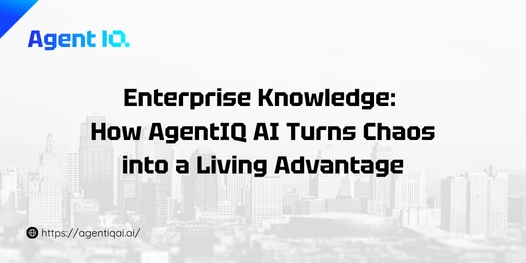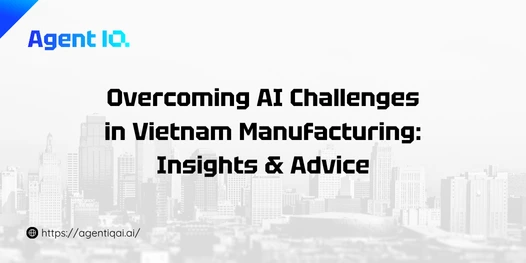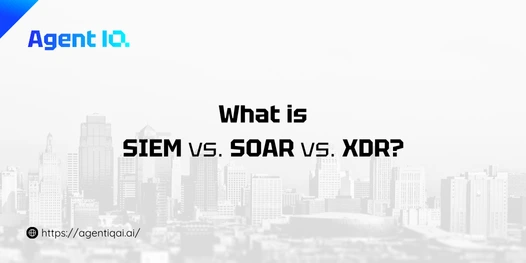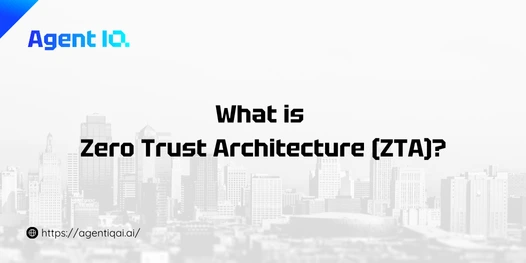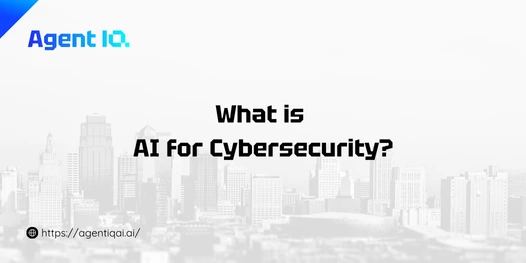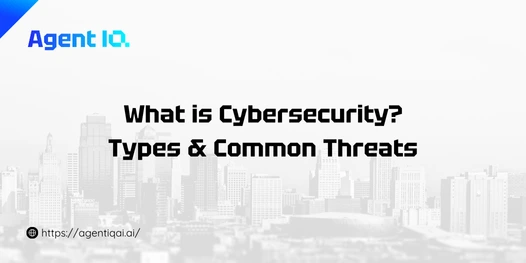From Insights to Actions: A Case Study of AgentIQ AI in Practice
- Publised October, 2025
In every modern organization, two forces drive value: what the company knows, and what its data reveals. Yet between those two worlds lies a widening gap — one that costs enterprises time, money, and agility.
While most organizations have already invested heavily in data systems (ERP, MES, etc.), few have truly connected them to the knowledge that defines how their business operates: policies, procedures, approvals, and experience.
In this case study, let’s see how AgentIQ AI close that gaps by combining both enterprise knowledge and dynamic data, bringing out a cohesive & actionable plan – all done on your enterprise knowledge.
Table of Contents
ToggleKey Takeaways
Why Enterprise Knowledge Is the Real AI Advantage
Your knowledge is your greatest asset: AgentIQ AI helps you capture, structure, and activate it — not replace it.
AI agents are tools, not the goal: They streamline access to your enterprise knowledge so decisions are consistent, fast, and compliant.
From PdM to Policy: The same logic applies to finance, logistics, customer service, or healthcare — anywhere knowledge meets data.
Faster, safer, smarter operations: Turn insights into actions in under a minute, without losing traceability or control.
Sustainable advantage: The knowledge you build becomes part of your organization’s permanent intelligence — a lasting competitive edge.
The pain-points every business meets
Every business already has knowledge — decades of expertise written into manuals, approval matrices, safety protocols, and best practices. And every business already has dynamic data — the continuous flow of insights from machines, customers, markets, and teams.
But these two pillars rarely interact in real time.
- A dynamic data system can detect an anomaly, but it can’t decide who should act, how, or when.
- Policies – SOPs – manuals & other operational workflows live buried in PDFs or SharePoint folders, disconnected from the live environment where decisions happen.
- Human coordination becomes the missing link between “knowing” and “doing.”
The result: decision latency, operational silos, and missed opportunities. Just a few “gap” can cost millions of dollars, and further undermine your business’s image. This is how you slowly lose control of your knowledge, and eventually lose profit.
As an executive, you can see the insight — but it takes hours or days before a compliant, resourced, and approved action happens.
In a world where every minute of downtime or delay compounds risk, that gap between insight and action is no longer tolerable.
The Current Solutions — and why they fall short
Most organizations have tried to address this in one of two ways:
- More dashboards and analytics tools.
They show what happened or what might happen next, but still rely on humans to interpret and coordinate across departments.
Data visibility is not the same as decision velocity. - Automation and chatbots.
Automation executes predefined tasks but doesn’t understand context — the “why” behind an action.
Chatbots retrieve information, but rarely orchestrate multi-step, compliant, cross-department workflows.
Both approaches add efficiency — but not on your enterprise intelligence. They automate fragments of work without unifying the enterprise’s most valuable asset: its knowledge.
How AgentIQ AI fills the gap between Knowledge and Action
AgentIQ AI was built on a simple but transformative idea:
the enterprise’s true intelligence lies in its knowledge — not in its individual systems.
Rather than deploying AI “agents” to mimic people, AgentIQ AI focuses on constructing, curating, and activating enterprise knowledge. It codifies the logic, rules, and expertise that already exist within your organization — transforming them into a dynamic, reusable asset.
Once built, that knowledge becomes the company’s permanent intellectual foundation — something that outlives systems, tools, and even organizational change.
AI agents then act as interfaces to that knowledge, utilizing it to provide instant, compliant, context-aware recommendations.
It’s not about deploying bots. It’s about building enterprise knowledge as an enduring asset — and using AI agents to unlock its full potential.
A Case-study: How AgentIQ AI transform insights to actions, using only Enterprise Knowledge
To understand AgentIQ AI’s impact, imagine an organization where data never moves faster than people — insights arrive, but actions stall. That’s where AgentIQ AI steps in: it bridges what your enterprise knows with what your systems see in real time.
Instead of treating “AI Agents” as the goal, AgentIQ AI helps organizations construct and operationalize their enterprise knowledge — turning it into a living asset that powers every decision, in any department.
This knowledge foundation — built from your policies, rules, processes, and expertise — becomes the intelligence layer that drives consistent, compliant, and optimized actions across the business. The Agents themselves simply serve as conduits, using that intelligence to plan, decide, and act faster than any manual coordination could.
To illustrate, we’ll look at a real-world scenario from manufacturing — Predictive Maintenance (PdM) — not because AgentIQ AI is limited to that field, but because it’s one of the clearest demonstrations of how knowledge and live data come together to solve universal business painpoints: delays, fragmentation, and information loss.
In this example, AgentIQ AI receives a live data alert, contextualizes it through the organization’s knowledge base, and produces an executable, compliant plan in seconds — showing, tangibly, how knowledge orchestration transforms insight into action.
Knowledge-base Set-up
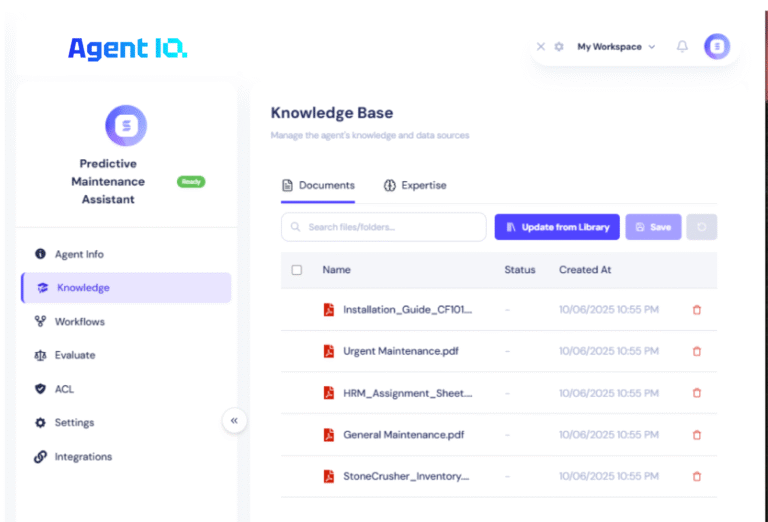
Every AgentIQ AI deployment begins with an enterprise-curated Knowledge Base — built entirely from the organization’s own materials: rules, manuals, SOPs, approval matrices, and internal policies. This ensures that all intelligence stays within enterprise control.
No external or public data sources are introduced at this stage. The Agent’s reasoning, recommendations, and workflows are driven purely by what the enterprise already knows, encoded into structured, accessible knowledge.
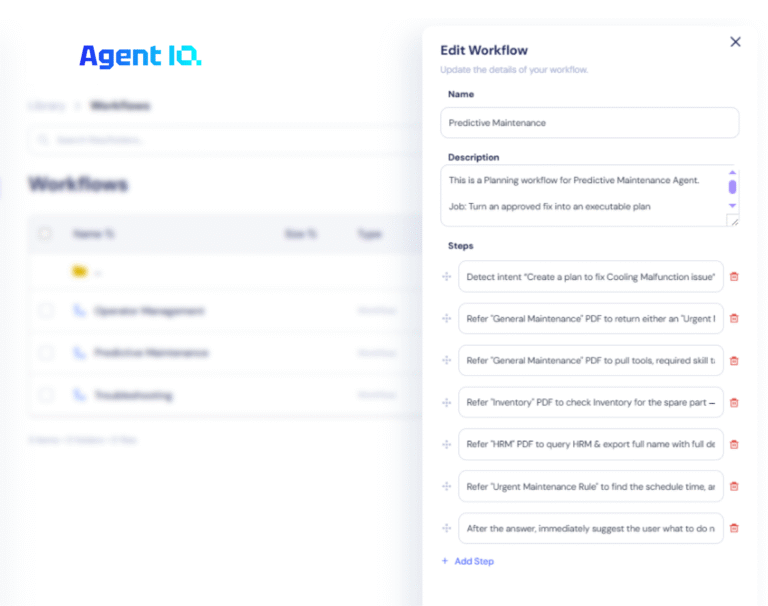
In essence, the Knowledge Base becomes the digital backbone of the organization’s expertise — continuously refined, fully governed, and used exclusively to power the enterprise’s AI Agents in a secure, private environment.
Let’s take a brief look at what knowledge we have uploaded to this Agent.
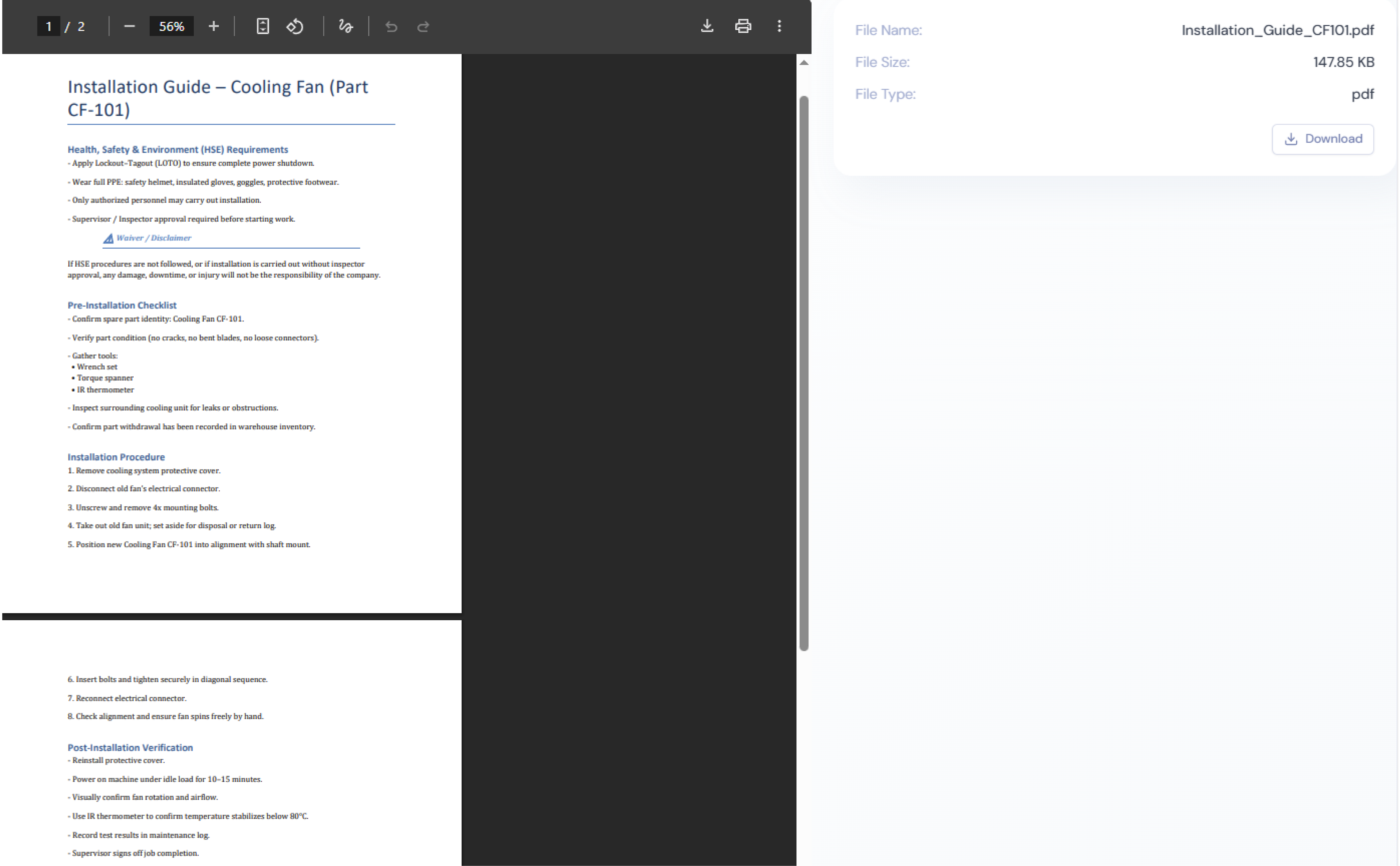
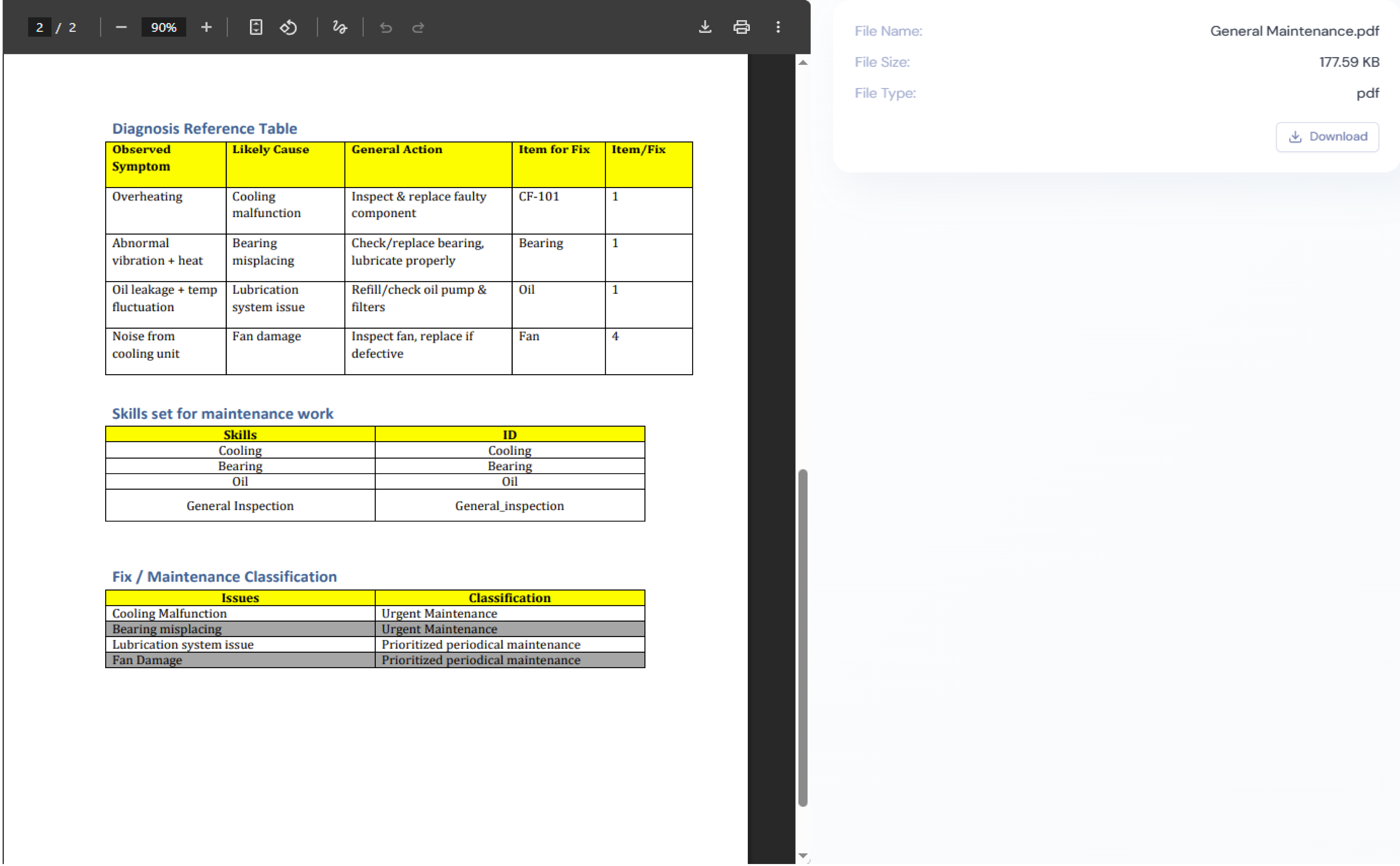
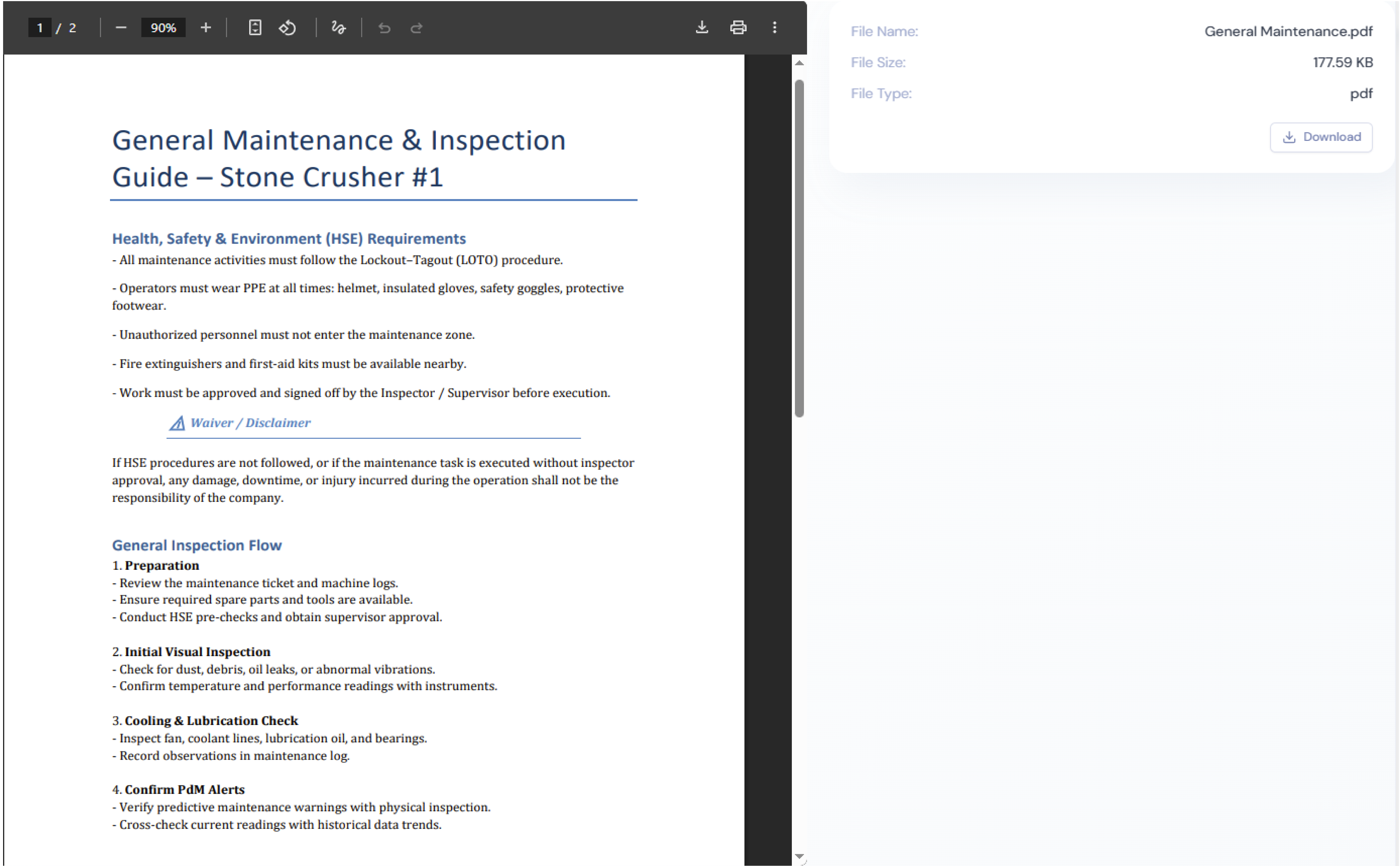
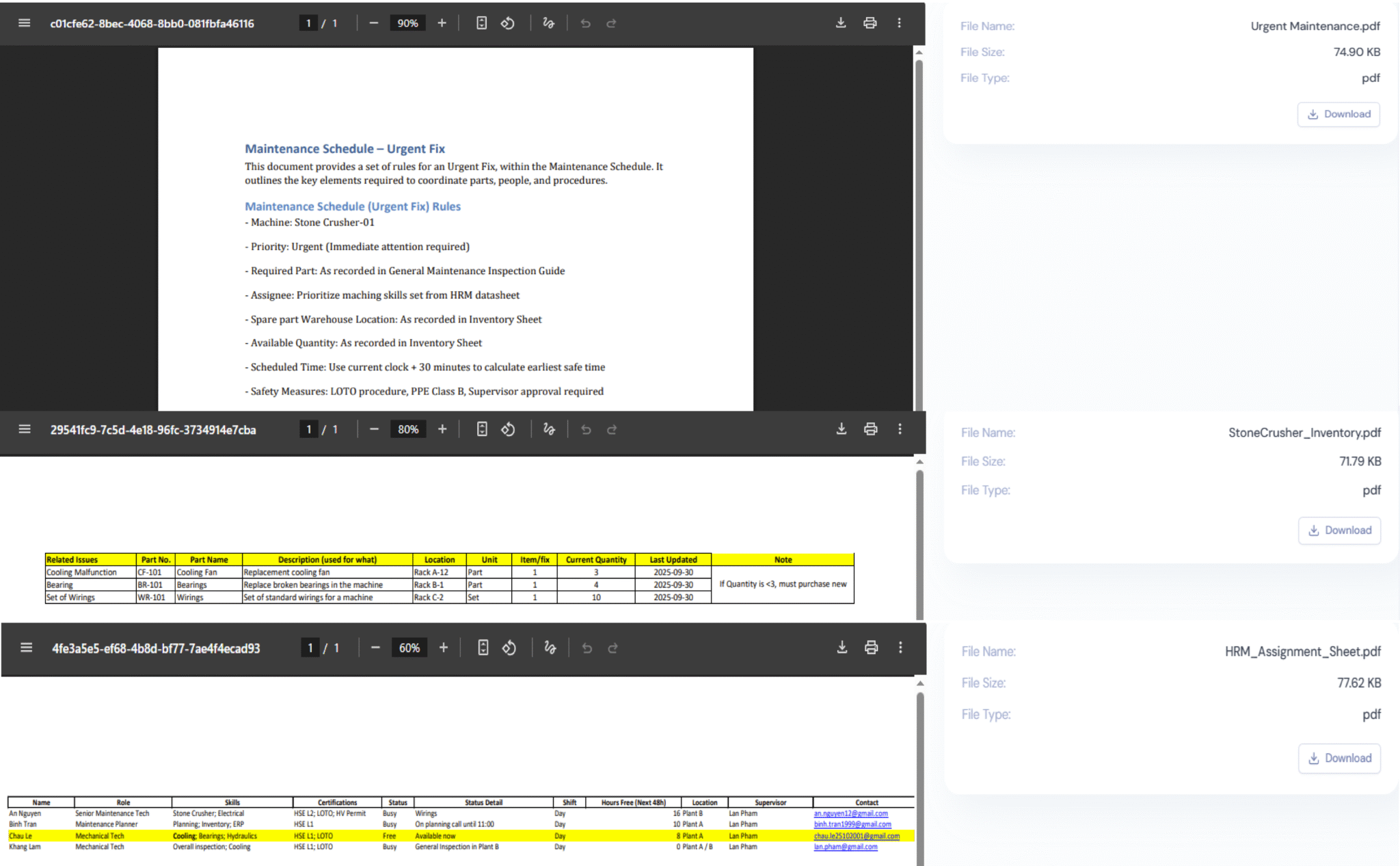
Once the enterprise knowledge base is established, the next step is defining how the Agent uses that knowledge — through customizable workflows.
Each workflow represents the organization’s decision logic:
how to classify issues, identify required resources, assign responsible personnel, and determine when and how an action should take place, and even more. All within the control of your Enterprise.
In this case study, the Predictive Maintenance (PdM) Agent draws from five core knowledge documents:
General Maintenance Rules – safety gates, PPE/LOTO standards, and classification logic.
Urgent Maintenance Rules – escalation and scheduling protocols.
Inventory – parts availability, locations, and restock rules.
HRM Assignment Sheet – technician skills, certifications, and availability.
CF-101 Installation Guide – technical procedures and validation steps.
The workflow ties these sources together — forming a reasoning path that allows AgentIQ AI to turn raw data (like an overheating alert) into a structured, compliant, and actionable plan.
In short, the workflow defines the “how,” while the knowledge base provides the “what” and “why.”
Together, they make every action traceable, auditable, and grounded entirely in enterprise knowledge.
PdM Agent Operation
Step 1: Receiving Ticket & summarize information
A predictive maintenance system detects overheating in a machine — a simple data event. In other industries, that “trigger” could be a financial anomaly, a logistics delay, or a customer escalation. This ticket is collected automatically to a live data system, ensuring complete security & seamless operation across the entire enterprise.
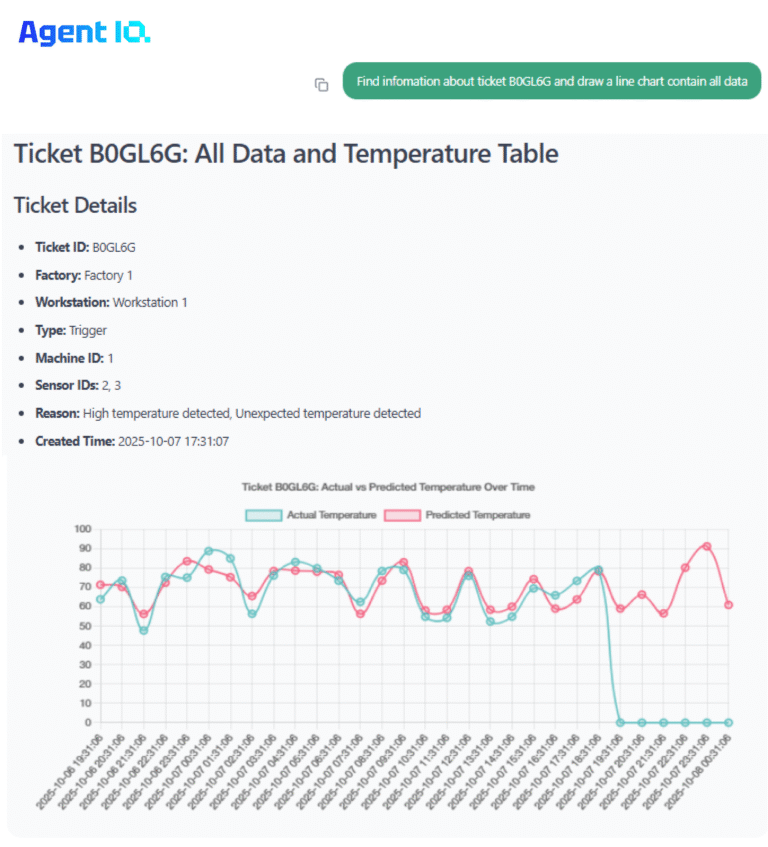
In this case study, the ticket #B0GL6G is collected automatically from PdM system, and all information has been shown to detect that an abnormal heat is to happen in the next 5 hours. Now, let’s see what we can do with just the detection.
Step 2: Diagnosis & Troubleshooting
AgentIQ AI retrieves and applies the company’s operational knowledge — safety protocols, inventory data, HR assignments, and urgency classifications. With a ready-to-deploy integration, your enterprise knowledge now can be further enhanced by dynamic – live data on the minute.
That knowledge isn’t generated by AI — it’s encoded from your real enterprise logic, built and owned by you. In this case study, we will ask the Agent what may cause “Overheating”, given that the detection is from abnormal heat expected.
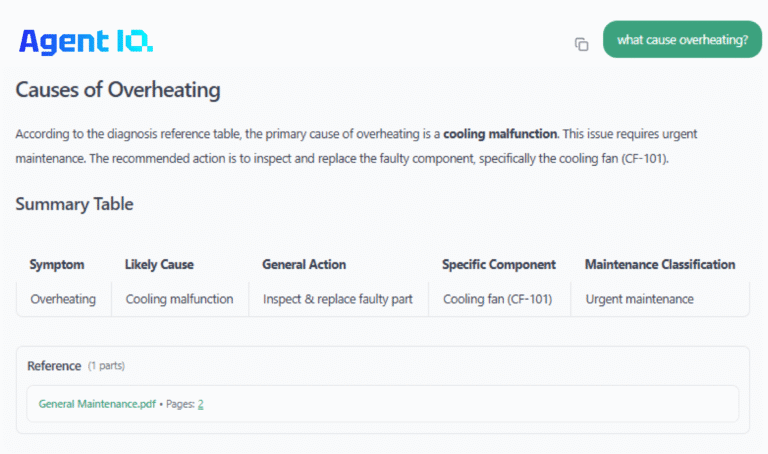
The answer is taken directly from the Knowledge-base, including diagnosis & suggested next-step.
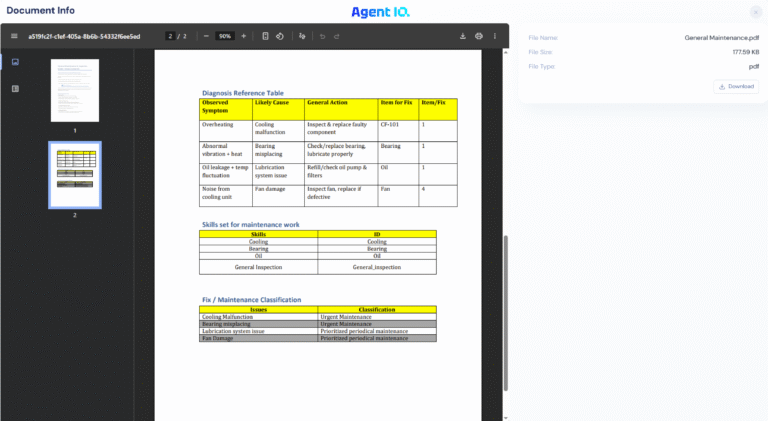
Step 3: Generate next-action plan
With just insights are not enough. AgentIQ AI furthers help enterprise create an actionable plan, using only what is instructed, and uploaded to the Agent by the enterprise. Now- let’s ask it to “Create a plan to fix this”
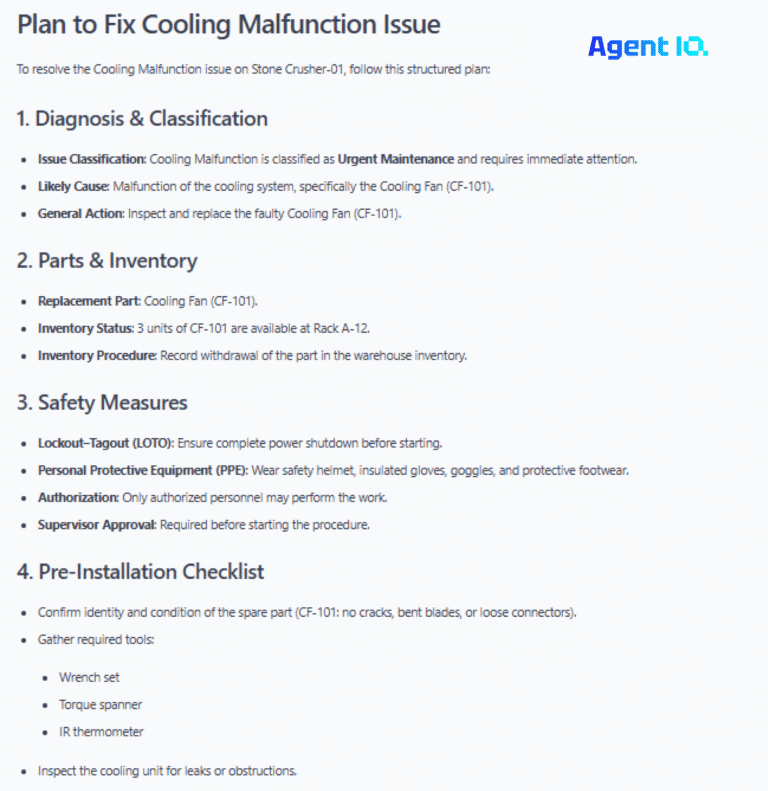
AgentIQ AI compiles these decisions into a cohesive action plan:
“Replace cooling component CF-101 — technician Chau Le — start in 30 minutes with supervisor approval and PPE Class B.”
However, this answer is not final, it can still be further optimized to your preferences. In this instance, we want it to include every details within the documents. For most tools out there, this feature is not available, or done without much application to the Enterprise Knowledge. With AgentIQ AI – we take this differently.
Technical Notes & Feedback is an important feature, it helps enterprise continuously improve their Knowledege-base, turning it into a living – always improving library. Let’s see how it is applied in this case.
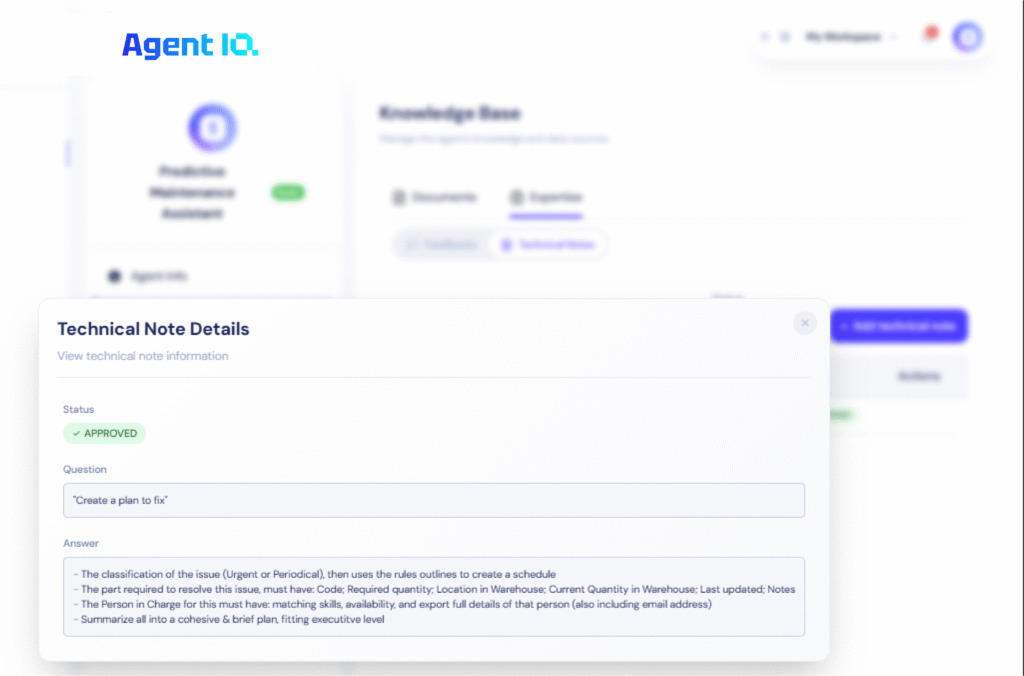
This technical notes is about what we expect an answer to contain. In a real-life scenario, it can be anything that you want to change. From what you expect an answer to contain, to even what kind of short-cuts you have discovered and you want it to update.
The best part is – these Notes & Feedbacks, is only verified by authorized account. Anyone can feedback, can contribute a technical notes, but only those who you trust with both expertise & experience can have the final say. This – is how you curate & govern your Knowledge Base, improving it as your business grows.
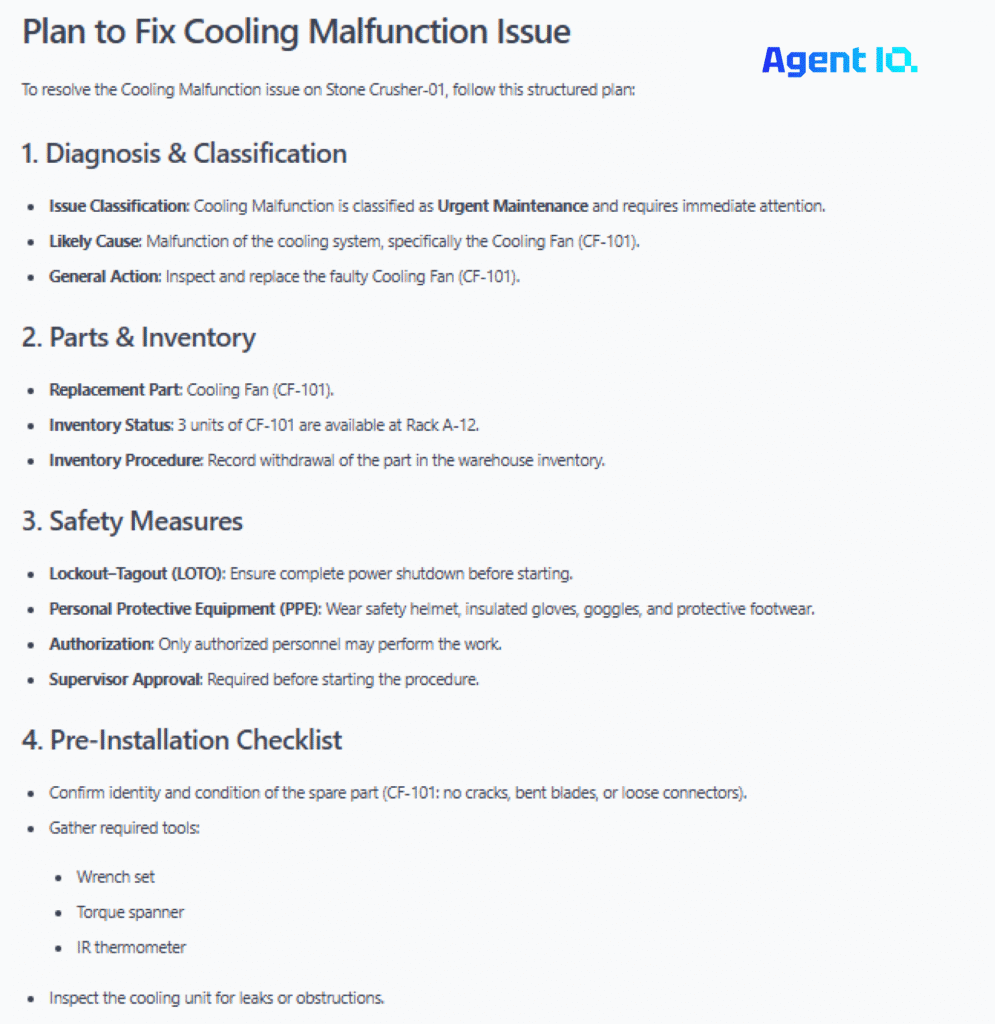
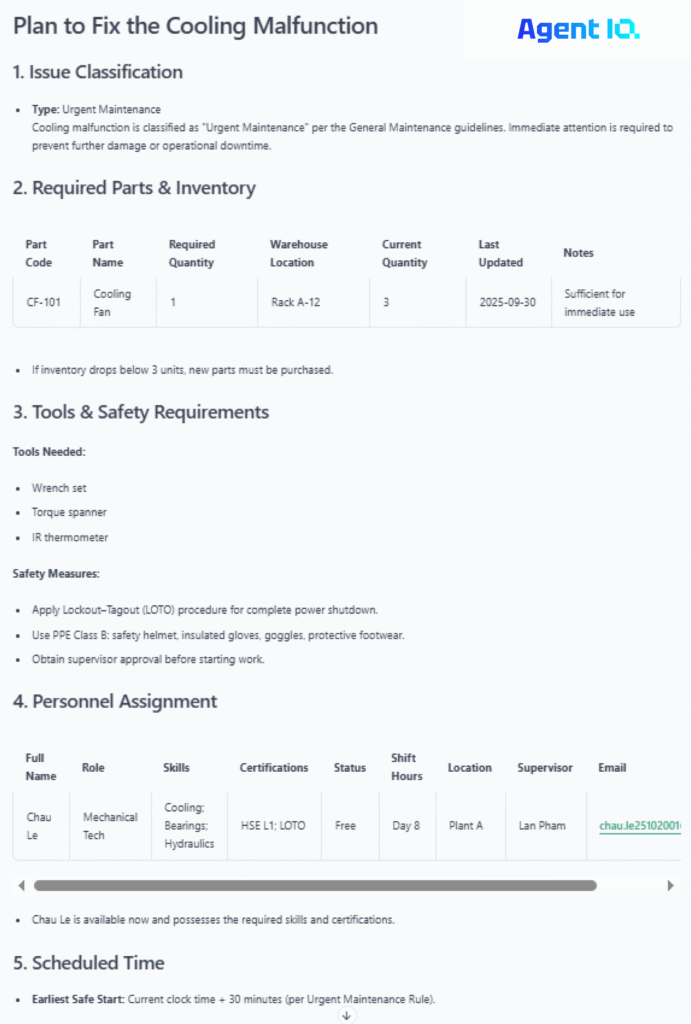
Step 4: Post-planning action
Planning does not just stop there, it is also about notifying that to the Person in Charge, and provide assistance. For this case, we will simplify it through an email to the PiC. In your use-case, it can ranges from email, scheduling & even meeting.
For this demo, we have created a sample email address, and ask the Agent to send a task email to that email address, almost instantly.
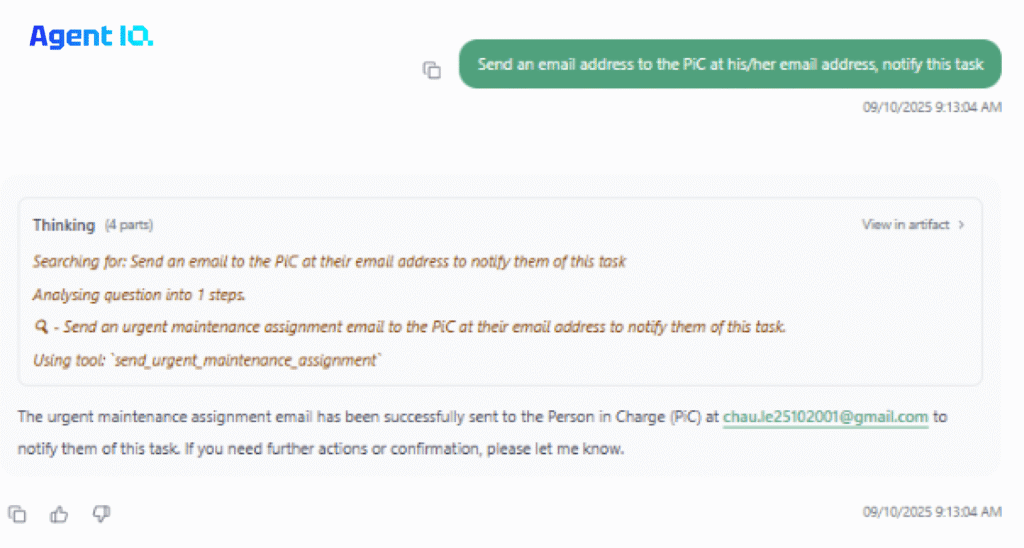
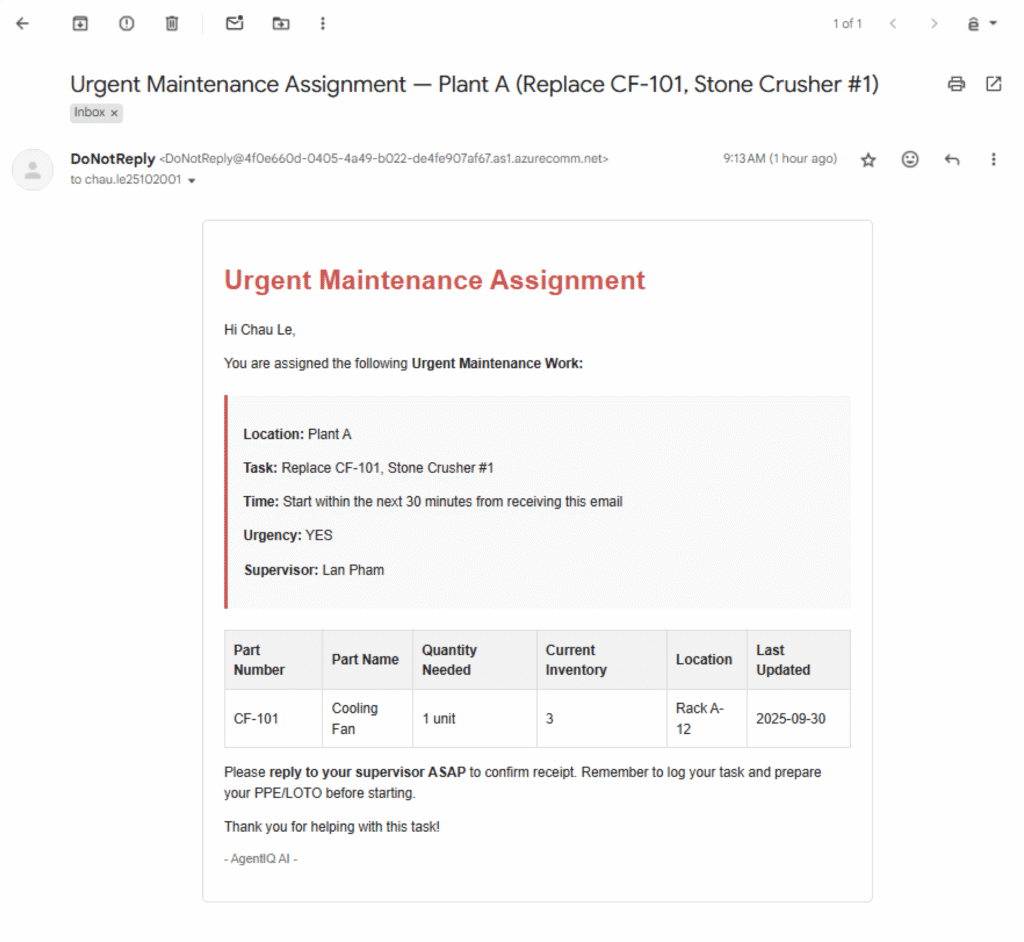
Benefits you can see
The impact of this orchestration is immediate and measurable.
- Speed & Agility
Tasks that once took hours of manual coordination — checking inventory, confirming personnel, getting approvals — are completed in under a minute. - Safety & Compliance
Each action follows the organization’s defined procedures — ensuring every plan respects HSE, HR, and policy gates. - Operational Efficiency
Fewer bottlenecks, fewer missed handoffs, and fewer dependency gaps between departments. - Institutional Intelligence
Every new scenario or expert note enriches your enterprise knowledge — turning it into a living, evolving business asset. - Scalability Beyond Manufacturing
The same orchestration logic can be applied across finance, logistics, healthcare, or customer operations — anywhere your business runs on structured knowledge and live data.
AgentIQ AI doesn’t replace expertise; it multiplies its reach across every corner of the organization.
In Summary
While PdM offers a concrete example, the same framework works across all industries:
- Finance: transaction anomalies → compliance-checked action plans.
- Supply Chain: shortages → auto-generated sourcing and logistics plans.
- Customer Service: complex tickets → mapped to internal knowledge and response workflows.
- Energy, Healthcare, Retail: alerts and data signals → converted into rule-based, safe, and documented actions.
AgentIQ AI is not a manufacturing solution. It’s a knowledge orchestration platform — designed for any business that values improvement, consistency, and sustainability through its own knowledge/
The true value of AgentIQ AI isn’t in its agents — it’s in the knowledge it helps you build and preserve.
Every rule, process, and best practice embedded into the platform becomes an enterprise asset. Even as tools evolve, that knowledge remains yours — institutionalized, searchable, auditable, and scalable.
AI agents simply make it operational — delivering that intelligence wherever and whenever it’s needed.
It’s not about replacing humans; it’s about giving every decision the full weight of your organization’s knowledge.
Your Knowledge, Your Agents, Your Control
Final Notes
With AgentIQ AI, organizations move from:
- Data to Decisions: turning insights into actions in seconds.
- Silos to Synchronization: aligning people, policies, and processes.
- Static Manuals to Living Knowledge: continuously improved and instantly applied.
- Tool-First to Knowledge-First: building an asset that compounds in value over time.
AgentIQ AI makes knowledge perform. It connects systems, empowers teams, and enables decisions that are not only faster — but smarter.
As AI adoption accelerates, competitive advantage won’t come from who has more tools, but from who has mastered how to encode, connect, and activate enterprise knowledge.
AgentIQ AI enables that mastery:
A foundation for lasting intelligence — where enterprise knowledge becomes an orchestrated, living system that powers every decision.
We don’t build agents. We build knowledge base that lasts.


